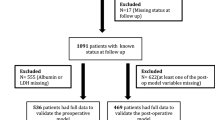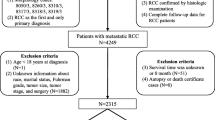Abstract
Objectives
To develop and externally validate a model that quantifies the likelihood that a pathologically node-negative patient with clear cell renal cell carcinoma (cRCC) has, indeed, no lymph node metastasis (LNM).
Patients and methods
Data from 1389 patients treated with radical nephrectomy (RN) and lymph node dissection (LND) were analyzed. For external validation, we used data from 2270 patients in the Surveillance, Epidemiology and End Results (SEER) database. We estimated the sensitivity of pathologic nodal staging using a beta-binomial model and developed a pathological nodal staging score (pNSS), which represents the probability that a patient is correctly staged as node negative as a function of the number of examined lymph nodes (LNs).
Results
The mean and median number of LNs removed were 7.0 and 5.0 (standard deviation, SD 6.6; interquartile range, IQR 7.0) in the development cohort and 5.6 and 2.0 (SD 8.6, IQR 5.0) in the validation cohort, respectively. The probability of missing a positive LN decreased with increasing number of LNs examined. In both the validation and the development cohort, the number of LNs needed for correctly staging a patient as node negative increased with higher pathological tumor stage and Fuhrman grade.
Conclusions
The number of examined LNs needed for adequate nodal staging in cRCC depends on pathological tumor stage and Fuhrman grade. We developed here and then externally validated a pNSS, which could help to refine patient counseling, decision-making regarding risk-stratified surveillance regimens and inclusion criteria for clinical trials of adjuvant therapy.


Similar content being viewed by others
References
Ljungberg B, Bensalah K, Bex A, Canfield S, Dabestani S, Hofmann F et al (2015) EAU guidelines on renal cell carcinoma: 2014 update. Eur Urol 67(5):913–924
Karakiewicz PI, Suardi N, Capitanio U et al (2009) Conditional survival predictions after nephrectomy for renal cell carcinoma. J Urol 182(6):2607–2612
Capitanio U, Jeldres C, Patard JJ et al (2009) Stage-specific effect of nodal metastases on survival in patients with non-metastatic renal cell carcinoma. BJU Int 103(1):33–37
Blute ML, Leibovich BC, Cheville JC, Lohse CM, Zincke H (2004) A protocol for performing extended lymph node dissection using primary tumor pathological features for patients treated with radical nephrectomy for clear cell renal cell carcinoma. J Urol 172(2):465–469
Capitanio U, Becker F, Blute ML et al (2011) Lymph node dissection in renal cell carcinoma. Eur Urol 60(6):1212–1220
Johnsen JA, Hellsten S (1997) Lymphatogenous spread of renal cell carcinoma: an autopsy study. J Urol 157(2):450–453
Lughezzani G, Capitanio U, Jeldres C et al (2009) Prognostic significance of lymph node invasion in patients with metastatic renal cell carcinoma: a population-based perspective. Cancer 115(24):5680–5687
Vasselli JR, Yang JC, Linehan WM, White DE, Rosenberg SA, Walther MM (2001) Lack of retroperitoneal lymphadenopathy predicts survival of patients with metastatic renal cell carcinoma. J Urol 166(1):68–72
Capitanio U, Abdollah F, Matloob R et al (2013) When to perform lymph node dissection in patients with renal cell carcinoma: a novel approach to the preoperative assessment of risk of lymph node invasion at surgery and of lymph node progression during follow-up. BJU Int 112(2):E59–E66
Capitanio U, Suardi N, Matloob R et al (2013) Staging lymphadenectomy in renal cell carcinoma must be extended: a sensitivity curve analysis. BJU Int 111(3):412–418
Hutterer GC, Patard JJ, Perrotte P et al (2007) Patients with renal cell carcinoma nodal metastases can be accurately identified: external validation of a new nomogram. Int J Cancer 121(11):2556–2561
Gonen M, Schrag D, Weiser MR (2009) Nodal staging score: a tool to assess adequate staging of node-negative colon cancer. J Clin Oncol 27(36):6166–6171
Kluth LA, Abdollah F, Xylinas E et al (2013) Pathologic nodal staging scores in patients treated with radical prostatectomy: a postoperative decision tool. Eur Urol 66:439–446
Shariat SF, Rink M, Ehdaie B et al (2013) Pathologic nodal staging score for bladder cancer: a decision tool for adjuvant therapy after radical cystectomy. Eur Urol 63(2):371–378
Xylinas E, Rink M, Margulis V et al (2013) Prediction of true nodal status in patients with pathological lymph node negative upper tract urothelial carcinoma at radical nephroureterectomy. J Urol 189(2):468–473
Sobin L, Gospodariwicz M, Wittekind C (2009) TNM classification of malignant tumors. In: UICC International Union Against Cancer. pp 239–242. http://www.inen.sld.pe/portal/documentos/pdf/educacion/13072015_TNM%20Classification.pdf
Sobin LH, Wittekind CH (2002) TNM classification of malignant tumours. In: International Union Against Cancer (UICC). 6th edn. Wiley, New York, pp193–195. https://www.uicc.org/tnm-classification-malignant-tumours-6th-edition
Fuhrman SA, Lasky LC, Limas C (1982) Prognostic significance of morphologic parameters in renal cell carcinoma. Am J Surg Pathol 6(7):655–663
Eble JN, Sauter G, Epstein JI, Sesterhenn IA (eds) (2004) World Health Organization classification of tumours. Pathology and genetics of tumours of the urinary system and male genital organs. IARC Press, Lyon
Janowitz T, Welsh SJ, Zaki K, Mulders P, Eisen T (2013) Adjuvant therapy in renal cell carcinoma-past, present, and future. Semin Oncol 40(4):482–491
Leibovich BC, Han KR, Bui MH et al (2003) Scoring algorithm to predict survival after nephrectomy and immunotherapy in patients with metastatic renal cell carcinoma: a stratification tool for prospective clinical trials. Cancer 98(12):2566–2575
Zisman A, Pantuck AJ, Wieder J et al (2002) Risk group assessment and clinical outcome algorithm to predict the natural history of patients with surgically resected renal cell carcinoma. J Clin Oncol 20(23):4559–4566
Meskawi M, Sun M, Trinh QD et al (2012) A review of integrated staging systems for renal cell carcinoma. Eur Urol 62(2):303–314
Terrone C, Guercio S, De Luca S et al (2003) The number of lymph nodes examined and staging accuracy in renal cell carcinoma. BJU Int 91(1):37–40
Joslyn SA, Sirintrapun SJ, Konety BR (2005) Impact of lymphadenectomy and nodal burden in renal cell carcinoma: retrospective analysis of the National Surveillance, Epidemiology, and End Results database. Urology 65(4):675–680
Sun M, Shariat SF, Cheng C et al (2011) Prognostic factors and predictive models in renal cell carcinoma: a contemporary review. Eur Urol 60(4):644–661
Author information
Authors and Affiliations
Contributions
MR contributed to data collection, management and analysis, protocol development and manuscript writing and editing. SAB helped in protocol development, data collection, and manuscript editing. LAK performed protocol development, data collection and management, and manuscript editing. RHT, BCL, L-MK, VM, BF, PIK, MR and JDR performed data collection and manuscript editing. UC, AB and MR contributed to manuscript editing. MG and MA helped in data collection and management, and manuscript editing. SFS helped in project and protocol development, data collection and analysis, and manuscript writing and editing.
Corresponding author
Ethics declarations
Conflict of interest
The authors declare that they have no conflict of interest.
Ethical approval
Institutional review board approval was obtained by all participating centers and provided institutional data sharing agreements in accordance with the ethical standards of the institutional and/or national research committee.
Informed consent
Informed consent was obtained from all individual participants included in the study.
Rights and permissions
About this article
Cite this article
Rieken, M., Boorjian, S.A., Kluth, L.A. et al. Development and external validation of a pathological nodal staging score for patients with clear cell renal cell carcinoma. World J Urol 37, 1631–1637 (2019). https://doi.org/10.1007/s00345-018-2555-5
Received:
Accepted:
Published:
Issue Date:
DOI: https://doi.org/10.1007/s00345-018-2555-5




